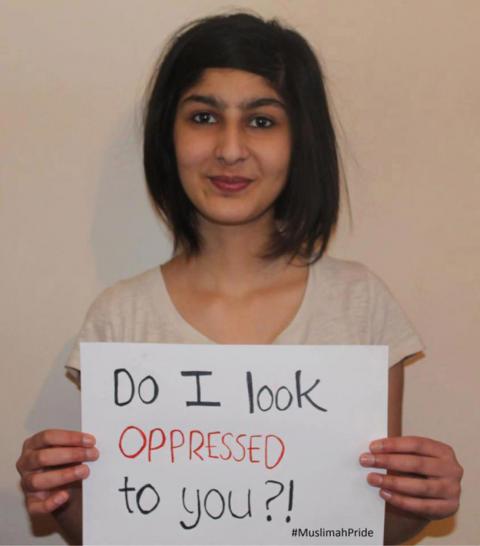December 19, 2014 - 11:43

Rebecca Cook
360 Cluster: Identity Matters
December 19, 2014
Intersectionality at its Most Compelling - Changing Views of Muslim Women in Demonstrating Similarities



(Muslamah Pride Image from http://www.nydailynews.com/news/world/muslim-women-organize-topless-jihad-day-article-1.1309582, Women Yelling Image from http://www.aljazeera.com/indepth/opinion/2013/03/201332715585855781.html, Islamic feminist symbol from http://en.wikipedia.org/wiki/Islamic_feminism)
Marjane Satrapi’s graphic novel, Persepolis, makes important strides toward altering how Western audiences perceive Iranian women. Satrapi endeavors to display the intersection of the lives of some Westerners with her life as an Iranian, who spent some time in the West. Satrapi, dissatisfied with representations she saw of Iranian women in France, decided to challenge them. In her words, “From the time I came to France in 1994, I was always telling stories about life in Iran to my friends. We’d see pieces about Iran on television, but they didn’t represent my experience at all. I had to keep saying, ‘No, it’s not like that there.’ I’ve been justifying why it isn’t negative to be an Iranian for almost twenty years. How strange when it isn’t something I did or chose to be?” (Satrapi, “Why I Wrote Persepolis” 10). In acknowledging both Eastern and Western feminism, Satrapi’s novel humanizes the female Iranian perspective in a way that can easily digested by Western audiences.
This novel acts as an autoethnographic text, a term coined by Mary Louise Pratt, in which Persepolis acts as “a text in which people undertake to describe themselves in ways that engage with representations others have made of them” (Pratt 35). This novel, which depicts her life so far, demonstrates a mastery of the spaces of representation. As one theorist has argued, “In discussing Persepolis in relation to the theme of women and space, we will draw upon a framework suggested by Pollock for reading the work of women artists…Pollock refers to three spatial registers: first, the locations represented by the work (and, in particular, the division between public and private space); second, the spatial order within the work itself (concerning, for example, angles of vision and other framing devices); and third, the space from which the representation is made, including the working space of the artist, and more generally the social and psychic space within which she is located, and within which her work is received” (Miller 39). The third space to which Miller refers, that of the working, psychic, and social space of the author, is the one in which Satrapi chooses to engage her readers.
Utilizing nego-feminism, questioning subordination and preexisting understandings of culture, and the stark depictions of a graphic novel, Satrapi makes a compelling case in humanizing Iranian women like her. In this way, Satrapi reclaims the space of her identity and how it is represented and the ethics of doing so, and alters it in order to provide a more representative picture of her life in Iran. Satrapi tells her story with images of privileged characters whose politics, financial situation, and values well match those of liberal Westerners. Further, she demonstrates her autonomy, independent of the regime, in which she also is able to demonstrate her passion for spirituality and nationalism. She begins her story from a child’s perspective in order to alter preexisting perceptions about Iranian women overall proving her strong love for her family in a way that echoes American values.
Satrapi is a self-proclaimed pacifist who wishes more children could study abroad, arguing that having experienced that; you cannot hate what you know (Satrapi, “Why I Wrote Persepolis” 11). Satrapi was able to pursue a study abroad experience, but recognizes that her experience required privilege and access. Acknowledging that not everyone could experience this perspective, in Persepolis, Satrapi, as the protagonist, describes her experiences studying in the East and the West, beginning from a child’s perspective, one that Westerner’s could easily empathize with, knowing little about the political undercurrents of Iran. Her childhood perspective also reflects her degree of privilege, and she seems to overtly utilize Western embodiments of privilege in order to welcome the reader to feel at home. For example, in Satrapi’s story, all the characters are white, her depiction of God is as a white, old man, and her family is noticeably wealthy, even in comparison to some of Satrapi’s peers in the memoir. Given her socioeconomic status, as a protagonist, she was able to experience and share her personal rebellions. As a child, she outwardly denounces the notion of a social class, mainly in failing to understand why she should not be allowed to have a crush on the boy who lives next door because he belongs to a different class. Further, as a teenager, embodying many of the Western associations with rebellion, Satrapi proudly claims her liberal perspective while Vienna.
Many of Satrapi’s actions in Persepolis demonstrate her self-possession. Even as a child, she demonstrates a facility and freedom of speech that embodies American values. Throughout the book, she independently moves on her own, is unafraid to speak her mind, works for social activism, and endeavors to create an equal world for all. Overcoming Western stereotypes that women have no voice in Muslim countries in the Middle East, Satrapi easily marries and gets divorced. Echoing these thoughts, Miller explains that one should “interpret the book within a liberal-humanist framework, according to which ‘Marji is just like any other teenager in the West’ but one whose normal rebelliousness over dress codes is transformed in the context of Iran into resistance to the fundamentalist theocracy” (Miller 45). Satrapi’s outspokenness allows her to express herself and her strong sense of what is right. In supplying pictures of a world in which Muslim women can express themselves in similar ways to Western women, Satrapi utilizes
Western feminism as a means to make apparent notions and embodiments of Eastern feminism.
Quoting Western feminist philosophers and feminists (mainly Simone De Beauvoir, in the chapter “Pasta”) Satrapi as a protagonist develops her own perspective and shows experiences where she broke through expectations that were set for her. Once she established a framework in which readers could sympathize with their own Western perspective, she included experiences in which, while still relevant to Western politics, she fought political traditional values on behalf of “modernity.” For example, in “The Convocation,” as an adult, she designs a new school uniform that once limited her self expression into one that was more accommodating of personality: she created an outfit with a short head scarf and wider trousers, instead. In this circumstance, Satrapi sympathized with Westerners in a way that is thought-provoking: “[the veil] has been co-opoted both into the ‘Western narrative of Islam as oppressor and West as liberator’ and into the alternative narrative of ‘the essentialness of preserving Muslim customs, particularly in regard to women, as a sign of resistance to imperialism.’ It may be argued that Satrapi colludes with the first of these narratives by portraying the imposition of the veil solely as a coercive measure introduced by an Islamic regime that had usurped the victory of the surprising against the Shah” (Miller 42). This example demonstrates her facility for expression and changing her situation, ultimately showing that Iran has become less strict than Westerners might assume.
The values Satrapi’s choses to espouse as a protagonist also reflect certain Western values. In the first chapter, she explains that she “was born with religion” (Satrapi, Persepolis, 6). She devotes herself to her religion and serving God, frequently talking with him while she is preparing to sleep. Satrapi is also very proud of her nationalism, as evidenced by “The Vegetable.” One could easily tie the symbolism of religion and nationalism with certain Calvinist values that have manifest in American culture. For Satrapi as a protagonist, faith is very important to her. Satrapi as a protagonist is also extremely family oriented, prioritizing her nuclear family over many aspects of her life. For example, her character moves back to Iran to be with them, she shows her rejuvenation from time with her mother, and ultimately chooses Iran and her family over some aspects of her self-expression, including being able to show her hair and ankles. In this way, like many Western stories, family factors into Satrapi’s creation of her own identity (Miller 47). Lastly, Satrapi includes her own focus on educating herself as a reoccurring value for her protagonist in Persepolis.
In quoting Mary Louise Pratt, “where there are legacies of subordination, groups need places for healing and mutual recognition, safe houses in which to construct shared understandings, knowledges, claims on the world that they can then bring into the contact zone” (Pratt 40). In Persepolis, Satrapi used the subordination she saw demonstrated in the media about Iran to fuel a powerful story that Westerners could empathize with, further demonstrating that identities as a strong, independent woman and feminist with family values cannot be separated by also being a Muslim Iranian. Satrapi uses a language expressed by pictures in a way that echoes Monsoon and Bennaifer, welcoming the Western reader into her own personal world in order to demonstrate the similarities and differences between the two of them. These pictures allow the reader to construct their own emotions in response to the striking black and white pictures that tell the story. This expression of her world fits the definition of nego-feminism--giving and taking from her reader, in providing for them sympathetic perspective coupled with experiences very different from what many Americans know and will ever experience (Naemeka 357). Further, Satrapi seeks to provide a different gaze, in Lacan’s terms, instead of “entering into the scopic regime of the European city unveiled, [Satrapi saw] herself being seen in a new way, and this gaze rearranges the very dimensions of her body. And in that distortion, she feels herself to be disintegrating and at the same time recomposing in alignment with a new image” (Gokariksel & Secor 196). She used the perspective conceived of by Western viewers, the one that had been created by her, and used it to demonstrate her similarities and independence. Instead of being forced into a new image, Satrapi chose to create her own, and changed Western perceptions in doing so.
Works Cited
Gökarıksel, Banu and Anna Secor. The Veil, Desire, and the Gaze: Turning the Inside Out. Signs, 40, 1 (Autumn 2014): 177-200.
Miller, Ann. “Marjane Satrapi’s Persepolis: Eluding the Frames.” Johns Hopkins University Press: L’Espirit Createur, Vol. 51, No. 1, Spring 2011: 38-52.
Nnaemeka, Obioma. “Nego‐Feminism: Theorizing, Practicing, and Pruning Africa’s Way.” Signs, Vol. 29, No. 2, Winter 2004, 357-385. Online.
Satrapi, Marjane. The Complete Perspolis. New York: Pantheon Books, 2004. Print
Satrapi, Marjane. “Why I wrote Persepolis: a graphical novel memoir: writer Marjane Satrapi faced the challenges of life in post-revolutionary Iran. She used the graphic novel format to tell her unique story.” Marjane Satrapi. Writing!, Nov-Dec, 2003, Vol.. 26(3), p. 9(5) Cengage Learning Inc.
